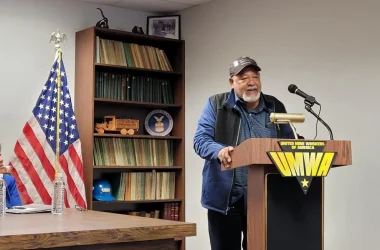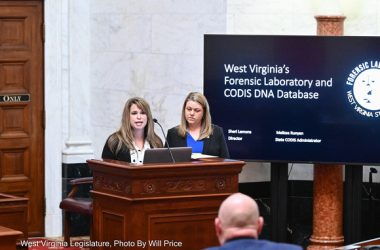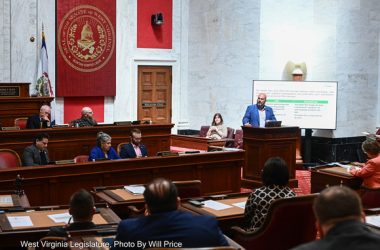By JIM ROSS
The State Journal
CHARLESTON, W.Va. — With exports poised to rebound and a coal-friendly president in the White House, things should be looking up for the coal industry.
Given the right circumstances, the industry could rebound some, but it’s not likely to bounce back to where it was a few years ago, experts say.
“We don’t think that coal is going to get back to its peak in 2018,” said John Deskins, director of the Bureau of Business & Economic Research at West Virginia University. “We don’t think that coal is going to get back to 150 (million tons). We think if coal gets back to 100 million tons, that’s a pretty optimistic scenario.”
According to the West Virginia Coal Association, West Virginia coal production peaked at 181.9 million tons in 1997, then declined and recovered to its most recent peak at 165.75 million tons in 2008. In 2015, it had fallen to 99.3 million tons, the first time production was less than 100 million tons since the mid 1970s.
Three-Front War
Deskins said three things combined to create the perfect storm for coal.First was the environmental and regulatory climate that increased the cost of burning coal. Second was the natural gas boom, which lowered the cost of burning gas to produce electricity. And third was weak international demand for coal.“International demand is picking up, finally. Global met prices are starting to improve, and exports are picking up,” he said.
Gas prices are moving upward, too, Deskins said. There has been a glut of natural gas in this part of the United States because the Marcellus and Utica Shale regions have not had enough pipeline capacity to take away what is being produced. If gas can be moved to other parts of the country or into export markets, that will help increase its price, and that will help coal, he said.
Deskins said he does not anticipate any additional regulations from the Trump administration that would increase the cost of burning coal. The problem is that much of the damage that has been done by regulatory action cannot be undone, he said. The power plants that closed because they could not comply with mercury and air toxics standards (MATS) requirements are not coming back, he said. Some of those plants have been or are being demolished.
Plants that were able to comply with MATS requirements won’t benefit if those requirements are rolled back because the investment has been made, he said.
The first Clean Air Act helped Southern West Virginia by making cheaper, dirtier coal from other regions’ less desirable to utilities. As more power plants added emissions control systems, Illinois Basin coal reclaimed some of the market share it had lost. Deskins said he expects Northern Appalachian coal to be stable for the foreseeable future, but coal from Southern West Virginia, where productivity is less than it is in the northern part of the state, will continue to suffer.
The Trump administration’s rollback of the Stream Protection Rule may prevent further harm to coal production and employment, but it won’t bring back any jobs or production that has been lost to other regulatory or market pressures, he said.
Deskins said he has not yet evaluated how the Jim Justiceadministration will affect the industry. That might not be known for a few more months, he said.
Arch Coal
Arch Coal is looking to its mines in West Virginia as the international market for metallurgical coal, the kind used in making steel, swings back to favor coal from U.S. mines. The flagship for Arch’s met coal operations is the Leer mine near Grafton in Taylor County, and Arch is considering opening new mines for met coal in the Tygart Valley region of Northern West Virginia.The metallurgical coal market is looking up, Arch says, because China is importing more met coal, high-cost mines have closed and worldwide demand has stabilized. U.S. met coal mines produced about 59 million tons last year, down from 71 million tons in 2015, and 2017 production is expected to be about 66 million tons, Arch says.Prices for met coal surged in the late summer and fall of 2016 before falling at the beginning of this year, but met coal, especially the type known as High-Vol A coal that is found in Northern West Virginia, is still selling for more than twice of what it was a year ago.
The closure of high-cost U.S. met coal mines has helped relieve the global oversupply. On the other hand, the cost of developing new mines could hold back new supply from reaching the market, Arch says in presentations it is making to investment analysts.
Only about a fourth of the met coal Arch mines is consumed in the United States. More than a third goes to Europe, with Canada, Asia and Brazil taking the rest.
Arch says its reserves in the Tygart Valley are comparable in geology and coal quality with what it has at Leer, and they should support decades of mining. Arch could replicate the Leer longwall mine and supplement new mines with room-and-pillar mining in the Tygart Valley.
“The Tygart Valley reserve block represents an exceptional organic growth opportunity for Arch — one that we believe is unequaled in the United States,” Arch Coal spokeswoman Logan Bonacorsisaid. “While it is premature to talk about when we might start producing from those reserves, we are currently in the permitting process.
“As we progress through that process, we will continue to closely watch metallurgical markets before making a decision to deploy capital, and we will only develop an additional mine should market and other conditions allow.”
The Leer mine is one of the largest producers of metallurgical coal in the United States and is one of the lowest-cost mines in the country, Bonacorsi said. Last year, the Leer mine sold 4.1 million tons to domestic and international steel producers, she said.
Arch’s Sentinel complex in Barbour County also produces High-Vol A quality coal and sold 1.1 million tons in 2016, Bonacorsi said. Together the two mines employ about 780 highly skilled men and women, she said.
The Mountain Laurel complex in Logan County and the Beckley mine in Raleigh County round out Arch’s metallurgical portfolio in West Virginia and provide the company with additional met coal qualities — High-Vol B and Low-Vol, respectively, Bonacorsi said.
In its investor presentation, Arch says the Trump administration is likely to focus on maintaining a strong and competitive domestic steel sector, and growth in infrastructure spending would be of benefit to domestic steel demand.
The company said it expects “a relatively smooth and expeditious permitting process” for its undeveloped metallurgical reserves.
Federal Effects
Robert Murray was in the Oval Office with some coal miners when President Donald Trump signed a congressional resolution overturning the Stream Protection Rule. Murray had long opposed the rule, and he was glad to see Congress and the president do away with it.“It was a deliberate attempt to eliminate underground mining with no environmental benefit, and they knew that,” Murray said.While in the White House, Murray gave the president a list of items he sees as necessary to help the coal industry recover from the damage he says was inflicted by former President Obama.
Murray said March 2, he was to meet with Vice President Mike Pence that evening to give him an expanded version of the list he gave the president.
If that is accomplished, coal can maintain its present share of the power generation market until the economy recovers and manufacturing picks up, Murray said. Coal-fired power plants are not running anywhere near full capacity, so they will be able to pick up the demand when manufacturing activity increases, he said.
The third item on Murray’s list is elimination of subsidies for wind and solar power. Coal can produce electricity for about 4 cents per kilowatt hour, but wind and solar cost about 26 cents before receiving a subsidy of 4 cents, he said. If wind and solar had to compete on a level playing field with coal, coal would win, he said.
Murray said the industry also needs to overturn an endangerment finding that determined carbon dioxide is a pollutant to be regulated by the EPA.
Also, the federal government needs to allow natural gas pipelines to be built and to allow ports to be built to handle exports of liquefied natural gas, Murray said. When the infrastructure is in place to move more gas from the Marcellus and Utica shales to domestic and foreign markets, the price of gas will go up and coal will become more competitive for power generation, he said.
And, he said, the United States needs to pull out of the Paris Climate Accords.
Murray said he is optimistic that Trump will help the coal industry. He was reluctant to give an opinion on West Virginia’s new governor until Justice acts or does not act on a West Virginia severance tax reduction.
Murray said West Virginia levies a 5 percent severance tax on coal, which is more than its surrounding states levy.
“The states that we compete against have no severance tax,” he said. “Pennsylvania, zero. Illinois, zero. Ohio, 10 cents a ton. Maryland, 15 cents a ton. West Virginia, it’s about $2.40 to $3 a ton,” he said.
West Virginia’s coal severance tax has cost the state about 25,000 jobs in the mining industry, Murray said.
West Virginia has balanced its state government budget on the back of the coal industry for years, Murray said. While the natural gas industry pays a severance tax, it’s not at the same level as what coal pays, he said.
“That 5 percent severance tax has hurt the West Virginia coal industry more than anything else,” he said. “We’ve got a chance to change things now on a national level, but West Virginia’s got to change. We can’t compete with other states. It’s a shame they’re bringing coal from ogther states into power plants in West Virginia.”
Murray said he would like to see the state’s severance tax reduced to 2 percent.
“We’ll have to see where Jim Justice comes out on this,” he said.
See more from The State Journal




